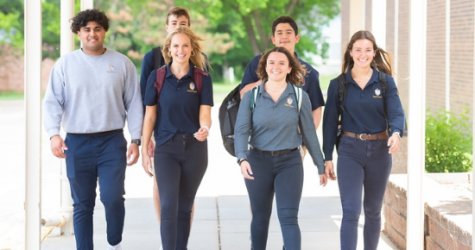No-Go on Dress-Code Change
Clean, neat, modest remains

October 5, 2022
Since the doors first opened at Totino-Grace High School in 1965, students have been required to wear a uniform. The uniform has changed since then to a more casual style, but students wish it was still less restrictive to showcase creativity and to feel more comfortable. The concern of the administration for allowing less restriction is based on students’ increased anxiety on out-of-uniform days, overall consistency, less comparison, and fewer distractions.
Let’s face it, waking up and not having to think about what students want to wear each day is nice, but at the expense of individual expression and personal style. Your personal style reflects who you are as an individual. It represents aspects of your personality, what you like and dislike, and how you see yourself. The clothes you wear are more than just pieces of fabric stitched together, they express us as individuals.
The administration feels uniforms make life easier for our students. Mr. Blake, Totino-Grace’s dean stated, “on out-of-uniform days, there is always a high increase of anxiety issues coming to our offices. Whether it’s the counselors’ office, talking to Weeks, or even coming to me, they are all issues of anxiety.” The anxiety is centered around not having trendy clothes, exclusion of group outfits and basically not fitting in. As he listened to reasoning for self-expression, he suggested, “there are many opportunities outside of school hours to show themselves. School is hard enough to have to worry about dressing up.”
The number one complaint from students around the Totino-Grace community and other private Catholic schools is that uniforms restrict students’ freedom of expression. They just want more freedom in their choices. The principal of Totino-Grace, Cheri Broadhead, feels there are ways to express individuality while in uniform. “I think there are so many ways for students to share their uniqueness through their personalities, shoes, jewelry. The dress code promotes consistency, less comparison, and fewer distractions.”
Along with not being able to express themselves, many students feel self-conscious in certain clothes. Students have different body types, one style may not look good on all.
Forcing students to wear clothes that they might not feel comfortable in could distract the students from learning. Their focus could be thinking about what they look like and how uncomfortable they are all day.

Mr. Vandermyde, Assistant Principal, thinks the changes to the uniform over the years have allowed for this. “Having uniform tops, but allowing freedom for pant choice is one change we’ve made to help the students feel more comfortable. If they don’t want to tuck in their shirt, then they have an option to wear a sweatshirt. I feel there is plenty of flexibility in the uniform policy.”
Another big factor in schools deciding to have uniforms is so kids don’t try to keep up with current trends. Some kids may feel self-conscious about not having the same brands other kids do. This comparison can have a negative effect, making students feel bad and possibly distracting the student from learning.
The battle for fewer restrictions on uniform policy continues. Tomorrow you’ll wake up, throw on the same old same old, swimming in a sea of blue and gray with a mix of khaki. No big decisions to make. Until out of uniform day.






Madi • Feb 16, 2023 at 3:05 pm
Very well written and informative